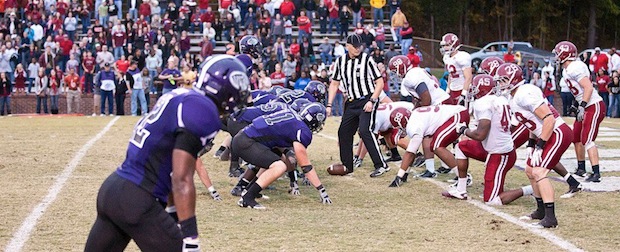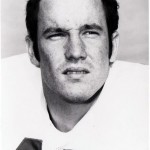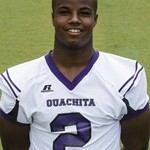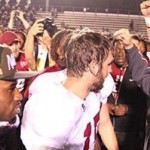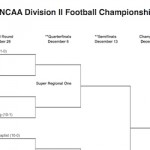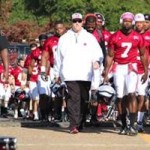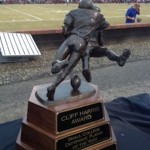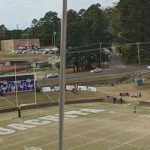 They’ll play another Battle of the Ravine in Arkadelphia on Saturday afternoon.
They’ll play another Battle of the Ravine in Arkadelphia on Saturday afternoon.
As has been the case for almost every football game played between Ouachita Baptist University and Henderson State University since the early 1960s, I’ll be there.
In my family, the day Ouachita played Henderson was as big as Christmas. It was far bigger than New Year’s Day. Growing up in the Ouachita Hills neighborhood of Arkadelphia, we could walk to both stadiums from our house.
The two Arkadelphia universities – one of which has Baptist roots and one of which has Methodist roots (the Baptists kept Ouachita, but the Methodists gave Henderson to the state) – first played each other in football in 1895. The series was suspended from 1951 until 1963 due to excessive vandalism. When they started playing again in 1963, I was 4 years old. You can bet I was there.
So it has been 50 years since my first Battle of the Ravine. Half a century. That’s hard for me to fathom. I always feel like a boy again during Battle of the Ravine week. I become giddy with excitement about the upcoming game and find it hard to concentrate on other tasks. Even though I’m in my 31st season of doing the play-by-play on radio of Ouachita games, I can assure you that the butterflies in my stomach will be such that I’ll be almost ill when we sign on the broadcast Saturday afternoon. I hope that never changes – that sense of anticipation, that realization of just how much this series has been a part of my life and the life of my family (my father played football at Ouachita and met my mother there).
I lived in Washington, D.C., during the late 1980s, where I covered Congress for the Arkansas Democrat. I missed the 1986 and 1987 games. I flew back for the 1988 game, which was called off with the score tied at the half because the field was flooding. The fact that there was a flood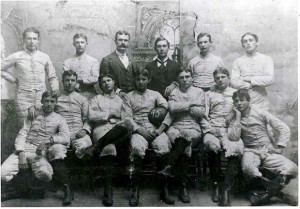 should not have surprised anyone who has kept up with this series through the decades. It has, after all, seen a bit of everything. That first game in 1895 was on Thanksgiving as Ouachita defeated what was then Arkadelphia Methodist College by a score of 8-0. For many years, the game was played on Thanksgiving.
should not have surprised anyone who has kept up with this series through the decades. It has, after all, seen a bit of everything. That first game in 1895 was on Thanksgiving as Ouachita defeated what was then Arkadelphia Methodist College by a score of 8-0. For many years, the game was played on Thanksgiving.
Want to hear more?
How about 1914 when Ouachita beat both Arkansas and Ole Miss but could only manage a scoreless tie in the final game against Henderson?
How about 1926 at Ouachita’s new A.U. Williams Field when Hardy Winburn broke loose for a 35-yard score in the rain to give Ouachita a 14-7 victory? This Saturday’s game will be played at a stadium still called A.U. Williams (albeit at a different location) and, yes, it might be raining.
How about 1949 when Ouachita trailed with seven minutes left in the game by a score of 14-0? Ike Sharp successfully executed three onside kicks for Ouachita in those final seven minutes and Otis Turner, who was known as the Magic Toe and later in life would be appointed as a judge on the Arkansas Supreme Court, kicked the field goal that gave the Tigers a 17-14 victory.
Ike Sharp’s son, David, just happens to be in his 15th year as Ouachita’s athletic director. And Otis Turner’s son, Tab, just happens to be one of the top trial lawyers in the country. Ike Sharp’s other son, the late Paul Sharp, won an NAIA national football championship as the head coach at Southwestern Oklahoma. Otis Turner’s other son, Neal, was once the chief of staff in the governor’s office. You guessed it. Both Sharp boys and both Turner boys played football at Ouachita. Family ties run deep in this series.
How about 1950 when more than 8,000 people turned out to watch Henderson avenge the previous season’s loss with a 7-0 victory over Ouachita? It would be 13 years before the two schools would play again.
How about 1963 as the series resumed with a 28-13 Henderson victory, allowing the Reddies to claim a share of the Arkansas Intercollegiate Conference championship?
How about 1969 when talented Henderson quarterback Tommy Hart led the Reddies back from a 17-7 halftime deficit? Henderson won 23-17 and captured the AIC title. Playing his last college game at Ouachita that day was a defender named Cliff Harris, who went on to play in five Super Bowls during the next 10 years for the Dallas Cowboys. Harris will be in Arkadelphia on Saturday as the two old rivals play yet again.
How about 1972 when Ouachita used a 47-yard touchdown run by hometown freshman sensation Luther Guinn with 2:23 to play to pull within one point at 14-13? Legendary Ouachita Coach Buddy Benson decided to go for two in that era before overtime. Ouachita quarterback Mike Carroll connected with Danny Jack Winston and the Tigers won, 15-14. Buddy Benson is no longer with us. But his grandson, Benson Jordan, will be the quarterback for Ouachita on Saturday. Did I mention that family ties run deep in this series?
How about 1975, which remains the greatest football game I’ve ever seen at any level? I’ve had the chance in my career to cover the Super Bowl, Cotton Bowl, Orange Bowl, Sugar Bowl and a lot more. This game beat them all. Henderson came in undefeated. Ouachita was 8-1.
Ouachita faced a fourth-and-25 on that cold, gray Saturday before Thanksgiving. The Tigers trailed 20-14, and time was running out. Ouachita’s quarterback was Bill Vining Jr. His father Bill Vining Sr., the Ouachita head basketball coach and athletic director at the time, had played in the series. His mother had been kidnapped by Henderson students when she was the Ouachita homecoming queen. By the way, have I told you that the family ties run deep in this series?
Bill Vining Jr. completed a 25-yard pass to Gary Reese. The chains came out. If the Tigers were short, Henderson would only need to kneel down a couple of times to have an undefeated regular season and a trip to the NAIA national playoffs. The chains were stretched, and it was still so close that the referee had to drop to his knees to examine the ball. When he stood up, he signaled that it was a Ouachita first down. I was a high school student and standing on the Ouachita sideline that day. I can picture it as if it were yesterday.
Two plays later, Vining connected with Ken Stuckey for the touchdown, and Russell Daniel kicked the extra point to give the Tigers a 21-20 victory. Ouachita and Henderson tied for the AIC title. Ouachita was one of the four teams selected for the NAIA playoffs, and Henderson headed to the first (and final) Bicentennial Bowl at War Memorial Stadium.
How about 1978 when Ouachita’s Benson decided to go for two at the end of the game, just as he had done six years earlier in that same stadium? Ouachita trailed 7-6 with 1:21 remaining following a Neal Turner touchdown pass to Jimmy Cornwell. Turner threw a pass in the direction of Ouachita star tailback William Miller (who now works in Tab Turner’s law firm) on the two-point conversion attempt, but Henderson’s Ned Parette knocked the ball away and the Reddies won by a point.
How about 1982 when Ouachita drove the length of the field for a late touchdown to win 19-18 at Henderson’s stadium and capture the AIC championship?
How about the game five years ago when Ouachita scored 27 fourth-quarter points to rally from a 29-16 deficit? In one of the greatest individual performances I’ve ever seen, Tiger wide receiver Julio Pruitt had 10 receptions for 250 yards and four touchdowns in Ouachita’s 43-36 victory, which was televised regionally. One of his touchdown catches was shown later that evening on ESPN’s top plays of the day.
Or how about two years ago? Ouachita had already wrapped up the first Great American Conference championship and was hosting
Henderson. The Reddies roared to a 41-17 lead late in the third quarter behind a freshman quarterback named Kevin Rodgers. Some of those in the stadium headed for the exits at that point.
Then, Ouachita quarterback Casey Cooper hit wide receiver Brett Reece for a six-yard touchdown.
Next, Cooper found tight end Phillip Supernaw for an eight-yard touchdown.
Finally, sophomore tailback Chris Rycraw scored on a 12-yard run with 3:47 left to make it a one-possession game, 41-36.
On the kickoff, Henderson fumbled, and Ouachita’s Ryan Newsom recovered at the Reddie 29. Henderson held on downs, and the Reddies got the ball back with 2:15 remaining. Henderson needed just one first down to be able to run out the clock. That first down never came. Christian Latoof’s punt carried 35 yards, and Ouachita took over at its 47 with 43 seconds on the A.U. Williams Field clock.
Cooper completed a 13-yard pass to Rycraw. Then, a 29-yard pass to Reece gave the Tigers the ball at the Henderson 11. On third-and-five from the Reddie six, Cooper completed a pass to Reece, who was pulled down a yard away from the end zone. A Cooper pass on first-and-goal was broken up by Chuck Obi. The clock showed six-tenths of a second remaining.
Ouachita had time for one play. Rycraw got the ball on a dive up the middle. There was a huge pile at the goal line. None of the officials signaled touchdown, though many on the home side thought Rycraw had scored. Henderson had held on, 41-36.
That play will be debated, cussed and discussed in Arkadelphia as long as anyone is still alive who attended the game. Henderson fans likely will tell you it was the greatest game in the history of the series. Since I bleed purple, I’ll tell you that the 1975, 1982 and 2008 games were better. For a Ouachita man, the ending of the 2011 game is just too painful to think back on.
Kevin Rodgers, the quarterback who led his team to victory as a freshman that day, is now a junior. Last year, he led Henderson to the first undefeated, untied regular season in school history. On Saturday, Rodgers will try to do it again. He’s a special athlete and a class individual to boot.
Chris Rycraw, the Ouachita tailback who got the call on that final play in 2011, will be playing his final game as a Tiger on Saturday, the memories of that disappointment still fresh on his mind. Like Rodgers, he’s a special athlete and a class individual.
Henderson is 10-0 and ranked fourth nationally in NCAA Division II by the American Football Coaches Association.
Ouachita is 7-2 and only three or four plays away from being undefeated after close losses to Harding and Southern Arkansas.
Henderson is heavily favored but this is, after all, the Battle of the Ravine. It’s the only college football game in America in which the visiting team walks to a road game. Only U.S. Highway 67 separates A.U. Williams Field from Carpenter-Haygood Stadium. Early Saturday afternoon, state troopers will stop traffic on the highway and the Reddies will walk across to play after having put on their uniforms in their own dressing room. At about 5 p.m., the troopers will stop traffic again and the Reddies will trudge back across the highway.
They’ve played 86 times through the years. Henderson has won 41 times. Ouachita has won 39 times. There have been six ties. Of the 86 meetings between Henderson and Ouachita, the game has been decided by a touchdown or less 38 times with Ouachita holding a 19-13-6 advantage in those games.
I realize my hometown bias. But others from outside Arkansas who have experienced the Battle of the Ravine tell me it is indeed among the great rivalries in all of college football. It might not receive the attention of Auburn-Alabama, Texas-Oklahoma or Michigan-Ohio State. Those who have played in these games, coached in them, covered them as journalists or simply watched from the stands understand.
They understand that there are few things in sports that can be compared to a rivalry between four-year schools that are within walking distance of each other.
They understand that in Arkadelphia, this is a battle that divides families.
If you’re a Tiger, you call it the Ouachita-Henderson game.
If you’re a Reddie, you refer to it as the Henderson-Ouachita game.
By the way, it’s maddening that the statewide newspaper and others several years back decided to use Ouachita Baptist and Henderson State on all references to the schools. No one associated with the schools talks that way. It’s simply Ouachita or Henderson.
If your team wins, you crow about it for the next 364 days. If your team loses, you feel the pain for the next year.
It’s Arkansas’ own football Civil War, a contest that once was promoted as the Biggest Little Football Game in America.
The lights have been on in both stadiums each night this week to discourage pranks. The signs on both campuses have been covered. Ouachita students guard the Tiger statue in the middle of the campus to keep it from being painted red. Henderson students guard the fountain at the entrance to the school to keep it from being filled with purple suds.
How close are these schools to each other? Consider the 1999 incident known in Arkadelphia as “Trashcam.” A Henderson graduate assistant coach took a video camera into Arkadelphia’s Central Park, which overlooks the Ouachita practice field. As he was taping the Tiger practice, the graduate assistant was spotted by a Ouachita player. The graduate assistant sped away in his car, leaving the camera in a nearby trash can. When the camera was found with a Henderson identification tag on it, Ouachita athletic director David Sharp removed the video and then returned the camera to Henderson.
It was the proper thing to do. The rivalry might be intense, but these folks have to live with each other 52 weeks a year. They sit in the same pews at church and find themselves next to each other in the waiting room at the dentist’s office.
I look at the clock and count the hours until Saturday’s kickoff. I love this rivalry. I do love it so.
Editor’s Note: This originally appeared on Sporting Life Arkansas last year.


